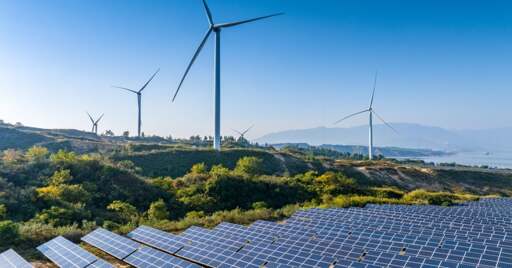Except you can’t power 24/7/365 with renewable alone, so you still need gas turbine backup.
A funny thing happened back in the middle 1800s. A man ran a 7-ton electric locomotive a mile and a half. The motor was powered by a storage device. In the late 1800s, people drove their cars around all day using a storage device. These storage devices became better and better, until they could power trucks and buses for hundreds of miles.
They are still getting better and better. Of course they can be depleted, and it’s good to havea backup methods to cover these cases and to keep the storage devices charged when there’s no sun or wind. Hydroelectric dams powered by water-storage are widely-used, and some flat places still burn fossil fuels to do that as well.
You need a buffer with at least 60 TWh in case of Germany. There is no economic electrochemical energy storage system for that capacity.
The easy solution is to just make green hydrogen. It’s an already solved problem, lacking only political will.
It is expensive though, so not a self runner in a free market economy.
Actual paper (not calling this a study since this appears to be non–peer-reviewed and only self-published): https://microgridai.centrefornetzero.org/ Be advised that this website relies on some Chromium-only trickery.
renewable microgrids […] compared to nuclear small modular reactors
A 95% renewable microgrid with 5% gas backup - in line with the UK’s Clean Power 2030 target - was modelled at almost a third (31.7%) lower cost than scenario 1 in today’s prices. In this model, the gas is restricted to just under 80MW (2/3rds the size of the data centre) and the model correspondingly chooses a larger battery for storage, and increases the size of wind and solar technologies.
I’m confused; how does 5% equal 2/3 the size of the data center modeled?
(Edit: Someone else suggested this: “I think the gas can supply 2/3 of the power that the data centre requires for situations when there is no sun or wind but only makes up 5% of the total energy used over a year.”)
They include a link to the model: https://github.com/ryanjenkinson/data-centre-modelling
Extreme incompetence in modeling. the github is complete crap. otoh their angelfire site does actually list some costs for the SMR.
They make the SMR side look absurdly cheap. $55/mwh power costs with 30c/watt capital costs is just absurdly low. Conservative SMR power estimates start at $180/mwh, and so actual microgrid costs would be over 80% lower.
More incompetence has their microgrid using off shore wind which is just stupid for HVDC requirement for small scale. Automatically too incompetent to trust their modeling. They don’t specify cost assumptions for any of the microgrid components.
wdym the github is complete crap? it has everything you mentioned you wanted to look at. and wouldn’t a too-low estimate for nuclear costs give extra validity to the claim that microgrids are much cheaper?
what is .nc file format? their csv data has no cost numbers.
wouldn’t a too-low estimate for nuclear costs give extra validity to the claim that microgrids are much cheaper?
It is much cheaper. Everywhere. But the modeling done in this instance can still be completely incompetent.
is this not cost? https://github.com/ryanjenkinson/data-centre-modelling/blob/main/notebooks/costs_2020.csv
https://stackoverflow.com/questions/36360469/read-nc-netcdf-files-using-python. and regardless, is a single file you don’t understand that is clearly read by the notebooks as input solar data enough for you to evaluate competence‽
https://github.com/ryanjenkinson/data-centre-modelling/blob/main/notebooks/model.ipynb does give model details, but doesn’t use that cost file directly.
some mistakes…
inflates 2021 costs to 2025 for all technologies. Solar has depreciated, and wind maybe did not go up in price. A bigger deal is no distribution costs. Offshore tall AF wind turbines are cheapest power in the world, if you build an island/raft at the bottom of the turbine to drink the power, and that is only scenario where they are part of a microgrid. They cost much higher than solar due to HVDC lines, and transformers to use “normal” current. Current conversion equipment in general also not included.
The gas costs overall are very low. Ridiculously low is fixed opex 1/4 that of wind. insurance about the same as solar, when people can get burned or poisoned “easily”, and mile wide craters have occurred at gas plants. No fuel delivery markups on futures prices, or infrastructure costs to deliver it. If it’s going to be 5%-20% capacity factor, delivery by truck is no infrastructure, but high fuel costs. Fuel delivery/handling for low capacity use makes coal look better. Fixed opex requires people operating 24 hours and emergency shutoff standy people.
Battery modeling is bad. Model uses constraint/linear programming to find a mix, but battery range is capped at 600mwh, with wind and solar at 2000mw, and so can fill battery in 20 minutes. Claim that at 600mwh, you only need gas for 5% of power, makes a gas plant a complete absurdity relative to a utility grid connection. A good battery size is 2 times the maximum charge rate.
SMR modeling is extreme joke. Based on 540mw reactor which simply is not even SMR. Normal big reactors are 1gw. They save substantial costs by having 4 to 8 on a site. The $55/mwh ($80 in 2025) figure from earlier is just variable/fuel costs. $5/watt construction costs not serious. no reason to ever expect under $15/watt. Neither of the numbers scale down to 120mw either, and nuclear is simply not a 24/7/365 capable energy source, even if you want your datacenter to be. If you need 12 hour maintenance windows, you need 1440mwh of battery systems that you will hardly every use. Nuclear was always stupid to consider, and a grid connection with possible exporting generation assets on site is the way to go.
Capacity factors for wind of 0.61 is high due to invalid offshore use. With 1400mw wind, and over 800mw wind per hour, a 120mw datacenter is horribly mismatched. Solar of 0.11 is 2.5 hours/day production. It’s a reason to have datacenter outside of UK, but onshore/onsite wind+solar can work for the right UK site. Solar for “off grid” in north should go for lower total capacity factor by maximizing tilt for winter production. Easy to get a full day’s power 9 months of the year, and find way to monetize surpluses. Grid exchange for datacenter application, smart. For datacenters, all electronics run on DC, which means they can all run off batteries, and everything else charges batteries.
The starting point with behind the meter renewable power with bidirectional grid connection is production required for maximum use + export on a 120mw transmission line per day = 5800mwh. 2600mwh battery to discharge up to 120mw all day is also 24 hours of operation power. Summer solar in UK will reach 8 hour days, and many 7 hour days. Onshore Wind averages 6 hours, but can hit 20 hours in a day. Model is $1.5m/mw wind, and $500k/mw solar (excluding grid connections) at capacity factors favours more solar. Natural DC power also favours solar. Wind has less land footprint, and could benefit from being on the north side, with (idk) solar panels helping rare south winds funnel up to the blades. The winter capacity factors are much higher for wind, and worth more than 3x the cost in winter. Other factors is export value of our electricity. A renewable future means higher night prices, and even in UK, higher winter prices. 24 hour huge battery means profit from day 2, 3 day ahead forecasts arbitrage.
The right model is 7 hours solar + 6 hours wind = 5800mwh (summer peak). and 6 hours wind + 1 hour solar = 1300mwh which is hoping for 50% self generation in bad solar winter days, but average wind. 200mw of wind and 650mw of solar at winter optimized angle gives 1850mwh on bad solar average wind winter day, and the 5800mwh summer maximum on mnay days with some curtailment possibility. up front power costs are $390m batteries, $325m solar, $350m wind = $1.065B. Over 1twh non curtailed self production per year. For 10% ROI on power production (nevermind datacenter companies having 5% cost of capital), $100/mwh is both export revenue needed and cost of internal power (which if you only needed 5% ROI/or financing burden is $50/mwh). This is lower internal costs than grid or just variable SMR power costs, and can often undercut competing supply for even higher profit. This is same annual production as 120mw 24/7 SMR, but that has $1.8B+ capital costs, and $180/mwh breakeven energy value (before the extreme variable/fixed operating costs). A 120mw fossil plant does mean just $30/mwh capital cost retrieval, but the operational costs are at least $60/mwh. OP Model underscores these heavily. The renewables approach achieves lower internal power costs + big profit opportunity from electricity trade. The variable costs of fossil fuel plants means they can’t just run 24/7 into a market price that loses them money, and so it only makes sense for datacenter to not share fossil power with rest of society.
thanks for the detailed analysis!
i’m curious though, https://en.wikipedia.org/wiki/Small_modular_reactor#List_of_reactor_designs says the design with the largest output is just 940 MWe and the second-largest output 600 MWe, are you sure they should be at least 1 GWe or am i reading something wrong?
https://en.wikipedia.org/wiki/NuScale_Power is the epitomy of scams in US/western nuclear and political corruption. SMRs are a new scam because larger units are unbankable and proven failures. The science for a theoretical on budget process makes SMRs more costly, even though the on budget time/costs of nuclear is not economic to begin with anymore.
NuScale SMR is about combining up to 12 77mwe reactors for your totals. It is up to budgets of $20/watt with variable costs of $120/mwh with still a handful of years to go before first completion. Vogtle spent a decade with a 3 year completion target, and budget doubled during that decade. They ended with $17/watt construction costs. SMRs also cheat on build costs by requiring ultra enriched (expensive/scary plutonium equivalent) fuel that is scarce without new build of military focused breeder/traditional reactors to provide adequate supply.
Of course. Renewable blows nuclear out of orbit when it comes to price. Nuclear plants take decades to build and are generally a lot more expensive than estimated.
That’s mostly because the west has become a bad place to build things, bike-shedding and a general loss of nuclear building expertise lost due to successful campaigning against nuclear by the fossil fuel industry.
We could be scaling up nuclear right now to help the goals for 2050 to be reached and then coast for a while as renewables pickup pace and fusion is finally cracked.
But no only thing people care about is immediate cost.
Yes renewables are cheaper per kw at the moment but they are also putting a lot of strain on the grid that’s not accounted for that’s expensive to upgrade, they are also not scaling up fast enough, which means there will be added cost to climate change.
Vs we could build nuclear reactors at a loss and bring on serious gigawatts of clean energy in a decade that would provide a stable baseline.
The west, the east, the north, the south… Wherever you build your reactor it will overshoot its estimated budget and wil be overshadowed by renewables.
But yes, there are many variables and the answer always lies in differentiating.
The Vogtle scam’s end cost was $17/watt. $8B or $4/watt was just financing costs prior to eventual operation that Georgia Power got to charge its customers for its share, over the 20 years before it gave them power from the boondoggle.
Solar costs under $1/watt to deploy, and batteries in a container (can fit under solar) costs $1 per 10 watt-hours of storage. Both last over 30 years.
SMR’s can pretend lower capital costs per watt, when excluding design/prototype time, but trade much more expensive enriched (proliferation risk) fuel that is less efficient, needs breeder reactors to provide likely from Russia, and carries higher security costs per watt. SMRs are simply a new scam to defraud investors with because nuclear is worthless as energy, and only ever is for military applications.
SMR’s can pretend lower capital costs per watt, when excluding design/prototype time, but trade much more expensive enriched (proliferation risk) fuel that is less efficient
The primary appeal of SMRs is their portability. Pointless for a data center, but vital for a large vehicle like a cruise liner or a shipping frigate.
Replacing our fleet of bunker fuel powered ships would be enormously beneficial.
The primary appeal of SMRs is their portability
There are micro/nano nuclear designs meant to fit in a truck trailer. They are under 1mw power, and not meant to be affordable for those who need more power than that. They are not space efficient to power ships. They may never be made, and just investor scams.
As for shipping, civilian use would be nightmare. Virginia class nuclear subs cost $2.7B. 5x more 2.2B more than best diesel submarines and have operational costs that are 4x higher than diesel subs. Wind power is path to decarbonizing shipping. That chinese airborne blimp windmill posted recently would work.
a commenter:
They claim to compare the cost of powering a 120MW data centre from a dedicated 470MW RR SMR compared to powering it from an 80MW gas turbine plus some unspecified number of wind, solar, and battery installations. For a study supposedly promoting wind, solar and battery technology, you would think they would tell us how many, what size, and what model of wind turbines they are modelling. But no, that’s left to vague hand waving.
on review this doesn’t appear to be entirely true; see my other comment: https://lemmy.world/post/36518843/19617823. still no specification behind the 43.4% stat, tho
Get out of here with your facts, reason and logic it’s not allowed. Don’t you understand we have to turn off all the deadly evil nuclear plants and stop them from poisoning the Earth and killing so many more people than all other methods of power combined /s
Fun fact, wind energy kills more people per year than nuclear has in decades.
where was i anti-nuclear
You weren’t but give it enough time and they will show up so I like to head them off
well why sabotage your own visibility by replying to my unrelated comment lol







